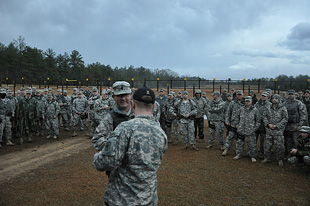All Army Small Championship Winner
During the first two days of pistol competition, Sgt. Maj. Chris Jenkins of the U.S. Army Institute of Surgical Research, Fort Sam Houston, Texas won Silver and Bronze medals for placing 2nd and 3rd in individual matches. He also earned a Bronze Excellence in Competition Pistol Shot Badge for placing in the top 10% of eligible non-distinguished competitors during the EIC match. The EIC badge is authorized for wear on the Army uniform and takes precedence over the Marksmanship Qualification Badge. Overall, Jenkins finished 13th out of 277 other competitors during the pistol competition.
The All Army Small Arms Championship was held at Fort Benning, Ga. Feb. 20-27.
The All Army Small Arms Championship is an annual advanced combat live-fire training event. Training and skill exercises are applicable to all military small arms firing disciplines. The intent of this competition is to develop combat firing skills at the intermediate level, recognize superior skill at the highest levels and to raise the standard of marksmanship across the entire force. The schedule of events includes two days of pistol, two days of rifle, one day of long range and two days of combined arms shooting.
Jenkins competed as an individual and joined five other Soldiers from the Soldier Medic Training Site at Camp Bullis, Texas, as a member of the Army Medical Department Center and School first ever Combat Shooting Team. Other team members included, Capt.Thomas Kennedy, Sgt. 1st Class Rey Flete, Staff Sgt. Christian Koscinski, Staff Sgt. Nick Coffey and Staff Sgt. Michael Smarr. Overall, the team finished 17th out of 47 total teams. According to Jenkins, "Most of the other teams had at least two professional level distinguished marksmen and other experienced shooters who have been competing in this event for years. All the AMEDDC&S team members were novice level competitors, so finishing 17th against such experienced marksmen was an outstanding achievement."
Pistol matches were timed and fired with the M9 Berretta at distances as far as 35 yards and as close as 10 yards. Scenarios changed for each match to include magazine changes; standing, kneeling, and prone shooting positions; slow/rapid fire; and shooting from a barricade. One team match started with a two mile run immediately followed by a timed match.
During the rifle competition, the team place 21st of 47 teams, with no individual awards.
Rifle matches were timed and fired with the M16A4 from as far as 500 yards to as close as 25 yards. Describing the rifle competition, SGM Jenkins said, "Scenarios and shooting positions were similar to the pistol matches, but the rifle matches were much more physically demanding. As an example, after shooting 10 rounds in 90 seconds from the 500 yard line, competitors were only given 90 seconds to run to the 400 yard line and shoot another 10 rounds. That pace and distance continued until competitors reached the final stage and had expended all their ammunition."
During the combined arms matches, the team placed 19th out of 49 teams, with no individual awards. The combined arms matches included firing 20 rounds from an AK-47 on full auto, the M9 Berretta pistol and the M16A4 rifle. During these matches, competitors were required to shoot targets from a marked area as fast as they could; change weapons if needed, run to a different area and shoot additional targets as fast a possible until all targets were down or all ammunition was expended.
After the competition, Jenkins said, "When I started training for this event, I thought I knew a good bit about marksmanship; but I was mistaken. I now know that any type of shooting is really very simple, it only requires two things; first, maintain a good site picture; second, have proper trigger control. However, for most people, keeping it that simple isn't so easy. 99% of all the mistakes made during the competition were mental mistakes, not physical or mechanical errors. Errors such as firing on someone else's target, firing on your own targets out of sequence, loading the wrong number of rounds in magazines, and shooting from the wrong position were common occurrences."
The AMEDDC&S team's coach, Sgt. 1st Class Russell Moore, USAR, repeated as overall champion again this year and he summarizes his pre-match thoughts like this, "Mongo pull trigger." Jenkins thinks "Sergeant First Class Moore is by far the best shot and best shooting coach I've ever met, because he is very positive, and is an excellent communicator; but when it comes time to perform, he has the ability to stop thinking and just keeps it simple. That is probably the biggest lesson the team learned about marksmanship during this competition."















